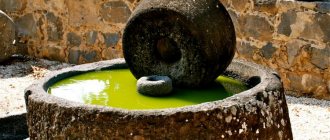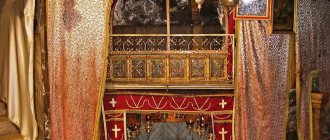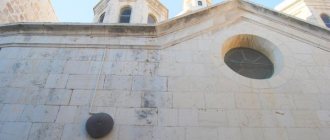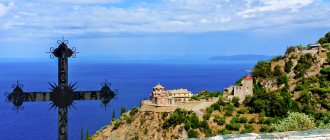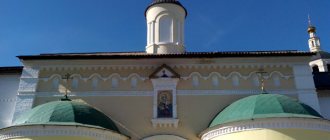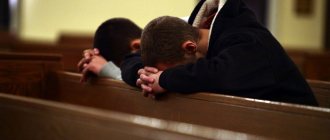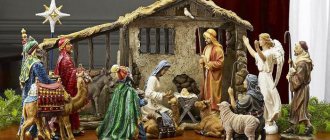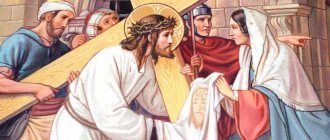To begin with, the Holy Sepulcher is not a “coffin” in the usual sense of the term - that is, a box for a dead body that could be moved from place to place. This is how Abbot Daniel, who visited the Holy Places at the beginning of the 12th century, described the tomb of Jesus: “It’s like a small cave, carved in stone, with small doors through which a person can kneel and enter... And when you enter this cave through small doors, on the right hand - like a bench, carved in the same cave stone: on that bench lay the body of our Lord Jesus Christ. Now that holy bench is covered with marble slabs.”
“The Burial of Christ”, painting by Dirk Bouts
Where is the Tomb of Jesus Christ?
The Old City of Jerusalem is a place of real power, where the political, mystical and religious, military, historical and scientific interests of all peoples converge. Millions of people have died in Jerusalem throughout the city’s long-suffering history. The small point on the world map where the Tomb of the Savior is located is the focus of the most important saints and at the same time dangerous currents that can threaten our world, or, on the contrary, save it.
Cathedral of the Resurrection of ChristOrthodox Church in Palestine
Muslims have the keys to the entrance to the temple.
Egyptian Sultan Saladin in the 12th century.
gave the keys to the gates of the Temple to the Judeh family, and the right to open the gates to the Nuseibeh family. Disagreements between Christian churches regarding the conduct of services led to quarrels.
Egyptian Sultan Saladin in the 12th century. found an original solution - he gave the keys to the gates of the Temple to the Judeh family, and the right to open the gates to the Nuseibeh family, who became a kind of arbiters in resolving conflicts between Christians.
This order continues to this day.
Secrets of the great Christian shrine - the Church of the Holy Sepulcher
The Patriarch of the Greek Orthodox Diocese, Theophilus III, initiated the start of work on the chapel over the Holy Sepulcher, the so-called Edicule. Here are his words:
“The decision to repair the Holy Edicule was made with the blessing of God. I don’t see human will in this, but only the will of the Lord.”
Since its construction, the Church of the Church of the Holy Sepulcher consisted of three parts:
- Temple on Golgotha.
- Chapels.
- Church of the Resurrection.
Over the centuries, the temple complex was destroyed several times and restored again.
Bloody wars were fought for him during the era of the Crusades. Scientists admit that not all the events that happened to him were recorded by historians. Therefore, the study of the Temple of the Lord is a study unprecedented in its scientific value. Some time after the burial of Christ, the Romans built a pagan temple on this site, and the cave-tomb was filled up. Christians managed to find the Holy Sepulcher again only in the 4th century AD. The excavations were led by Saint Helen of Constantinople, the mother of Emperor Constantine I. She tore down the hill and founded the Church of the Holy Sepulcher here and erected the Edicule.
Studying history is not the only purpose of the work in the temple. The current frame of the Holy Sepulcher was made at the beginning of the 19th century. But in 2016, scientists called his condition “very bad.” Other elements of the Edicule have also worn out.
October 27, 2016 is the historical date when the tomb of Jesus Christ was first opened. Archaeologists were given only two and a half days to carry out all the necessary work in the sanctuary. Researchers worked around the clock. Nowadays, where Calvary and the Tomb of Jesus Christ were located, the most important temple of Christianity is located - the Church of the Holy Sepulcher. The burial place of Jesus itself, where scientists work, is located in a small chapel (Edicule).
A widely known fact: the massive slab installed on the burial bed of Jesus Christ has a transverse crack. The slab is made of marble. But even for this material time shows no pity. The slab is constantly deformed under the influence of humidity. Carbon dioxide and nitrogen oxide, combining in the air with water droplets, form tiny particles of acid, which slowly but surely, at an average speed of 1 mm per 100 years, destroys marble structures.
Fortunately, this process is slower in Jerusalem, because the city is quite dry. The average annual humidity is slightly above 50%. This is much lower than in Rome, Paris, Moscow and many other cities rich in ancient temple complexes. However, the most important shrine of Christianity needs restoration.
Even before the restoration began, scientists examined the Holy Sepulcher using ground penetrating radar. As a result, rock fragments were discovered that were a continuation of the main rock mass of Golgotha. This is nothing more than the remains of the walls and floor of the cave, destroyed during the construction of the temple complex.
Several years have already passed since the Holy Sepulcher was opened. It seems that this is the beginning of such large-scale events that the ancients spoke about. What awaits us in the near future? Will the opening of the Tomb of the Lord bring the beginning of the Day of Judgment closer?
INTERESTING: Prayers to Jesus Christ for children.
The Savior's last bed
Archaeologists have also encountered other mysteries. What surprised them most was the bench in the tomb. Under the slab covering it there was a layer of stone fragments, then another slab - marble, with a cross carved on it - and already under it the very surface of the bench on which the body of Christ lay. What did this stone crumble mean? Perhaps the guards took away fragments of stone from the pilgrims, which they tried to take with them as souvenirs, and left them in the cave. During the reconstruction of 1555, for better preservation, the bed itself was covered with a marble slab, the accumulated fragments were piled on this slab and covered with another slab - a stone one. But the most amazing thing was that the surface of the Savior’s bed turned out to be untouched, while its “contemporaries” - the side walls of the cave - were destroyed at the beginning of the 1st millennium, during the reconstruction of the early Church of the Holy Sepulcher. Archaeologist Frederic Hiebert shared his impressions in an interview: “This is absolutely amazing. My knees are shaking because I didn’t expect this... We can’t say with absolute certainty, but at first glance, there is clear evidence that the tomb has not been damaged during all this time.” Further research showed that the bench on which Jesus lay did not have any mechanical damage, chips or deformations, and at the same time an amazing fragrance came from it. The scientific and repair work was successfully completed, but it is unlikely that their results can in any way influence the views of believers and non-believers. A non-believer will find explanations for the most incredible miracle, just as a believer will reject the most logical and convincing arguments of atheists. At the same time, in the history of the Holy Sepulcher there are many gaps and unclear moments. One of the most intriguing mysteries is connected with Russia.
Stone of Anointing
How to Worship the Tomb of Christ
One custom arose among Orthodox pilgrims: first you need to pray in the Angel’s chapel and venerate part of the stone rolled away by the Angel. Then, having kissed the low entrance, enter the Life-Giving Tomb, slowly reading the prayer to yourself:
Upon entering, you need to light candles, kneel and pray. Pilgrims often place icons, medallions and crosses they brought with them on the Bed for Consecration. Many touch with their lips and forehead the head, western and farthest part of the Lodge from the entrance. When leaving the sanctuary, walk backwards, so as not to turn your back to the Sepulcher.
RECOMMENDED: Why Jesus Christ was crucified.
The flow of pilgrims has not subsided for two thousand years
The Holy Sepulcher in Jerusalem from the very beginning became the main place of pilgrimage for Christians. Many of them left notes about what they saw. Pilgrims also came from Rus'. In Russian, we find the oldest description of the Holy Sepulcher in the “Walking” of Abbot Daniel of the 12th century:
The Holy Sepulcher is like this: it is like a small cave, carved in stone, with small doors through which a person can kneel and enter.
It is small in height, and four cubits in length and width.
And when you enter this cave through the small doors, on your right hand there is, as it were, a bench carved into the same cave stone: on that bench lay the body of our Lord Jesus Christ.
Now that holy bench is covered with marble slabs. There are three round windows on the side, and through these windows this holy stone is visible, and all Christians kiss there.
Five large lamps with oil hang in the Holy Sepulcher, and the holy lamps burn continuously day and night.
The holy bench where the body of Christ lay was four cubits long, two cubits wide, and half a cubit high.
In front of the cave doors lies a stone - at a distance of three feet from those cave doors: sitting on that stone, an angel appeared to the women and preached to them about the resurrection of Christ.
Abbot Daniel
pilgrim
Description of the 12th century. has practically lost its relevance to this day
Where is the grave of Jesus Christ according to Anglicans and other Protestants
One of the main attractions of the old city of Jerusalem is a place called the Garden Tomb. Many believe that behind the wall there is Golgotha and the garden where Jesus Christ was crucified. There, nearby in this garden, is the Tomb where His body was placed after the crucifixion.
Until now, disputes have not ceased about where Jesus Christ was crucified, where there was that place with three crosses, on the middle of which the Savior was crucified. At the end of the 19th century in the 90s, British General Gordon found this site, which is considered the most likely. This place, which is located in the center of Jerusalem, is the greatest Shrine of Christian history.
There was a garden in the place where Jesus was crucified. At the site of the Garden Tomb, archaeologists found tanks for storing olive oil and pressing grapes. This indicates that there were olive orchards and vineyards.
The ancient Jews of the time of Jesus Christ typically buried their dead in rock-cut tombs. These were stone crypts, which were then closed with huge stones. One of which is located in front of the entrance to the supposed Tomb of Jesus Christ.
The tomb was opened in the 60s of the 19th century and many scientists believe that this particular place is more suitable to what was described in the Gospel stories, where Jesus Christ was buried. The description tells us that it was possible to enter this tomb at full height. She was visible from the side. It was also new.
Garden graveCemetery in Palestine
Today this garden is run by Christians who carefully care for this place. This is one of the holiest pilgrimage sites in Jerusalem, where Jesus Christ lay.
USEFUL TO KNOW: Icon of the Resurrection of Christ.
The defeat of the crusading "special forces"
It is believed that the earliest slab covering the bed of the Savior was sent to the capital of the Byzantine Empire. However, in 1204, having received a report from the crusaders who had captured Constantinople, Pope Innocent III was horrified to discover that this slab was not on the list of captured shrines. Where did she go? One of the Novgorod epics tells how Vasily Buslaev took the lid of the Holy Sepulcher to Rus'. The epic, of course, is a work of art, but Buslaev cannot with all responsibility be called a historical figure. But here is an entry from the IV Novgorod Chronicle, dated “In the summer of 6719” (that is, in 1211), which speaks of a character who existed in reality: “Then Dobrynya Yadreikovich came from Constantinople and brought with him the Holy Sepulcher, and he himself was tonsured on Khu-tyn near the Holy Savior.” So, a certain Novgorod boyar Dobrynya Yadreikovich, returning to his homeland seven years after the capture of Tsar-grad by the “Latins”, brought with him the “Holy Sepulcher”. It is logical to assume that it was not about the Tomb, but about the slab that covered the last bed of Christ. During the destruction of Constantinople, the brave Novgorodian tried to save the shrine from the crusaders, in whom he (considering the then conflicts between Orthodox and Catholics) saw not so much defenders as desecrators of the faith of Christ. Such an act required a great reward, and, in general, it is clear that, having become a monk, he soon became the abbot of perhaps the most revered Varlaam-Khutyn monastery in the Novgorod lands. However, the news that the slab from the Holy Sepulcher was in the possession of the schismatics, of course, reached the “Latins” and should have caused them to be furious. Does this not explain the strange campaign of the “dog knights” of 1240, which ended with the Battle of the Neva? It raises too many questions, both because of its motivation, and because of the small number of the crusader army, and because of the enormous resonance that, in essence, a border skirmish caused on the scale of Rus'. Everything falls into place if we assume that the detachment of crusaders was not going to conquer Novgorod, but only to capture a shrine that was important for the entire Christian world. But, having landed at the mouth of Izhora, the European “special forces” relaxed, and local residents warned Prince Alexander. He took advantage of the enemy’s relaxation, struck a sudden blow and won a victory, which in the eyes of his fellow tribesmen was perceived as evidence that God had not yet abandoned Holy Rus'. However, given that Rus' was under the yoke of the Mongols, they somehow did not want to run into additional troubles, and the Novgorodians tried not to advertise the fact of owning such an important shrine. Could everything have been exactly like this? Why not?
